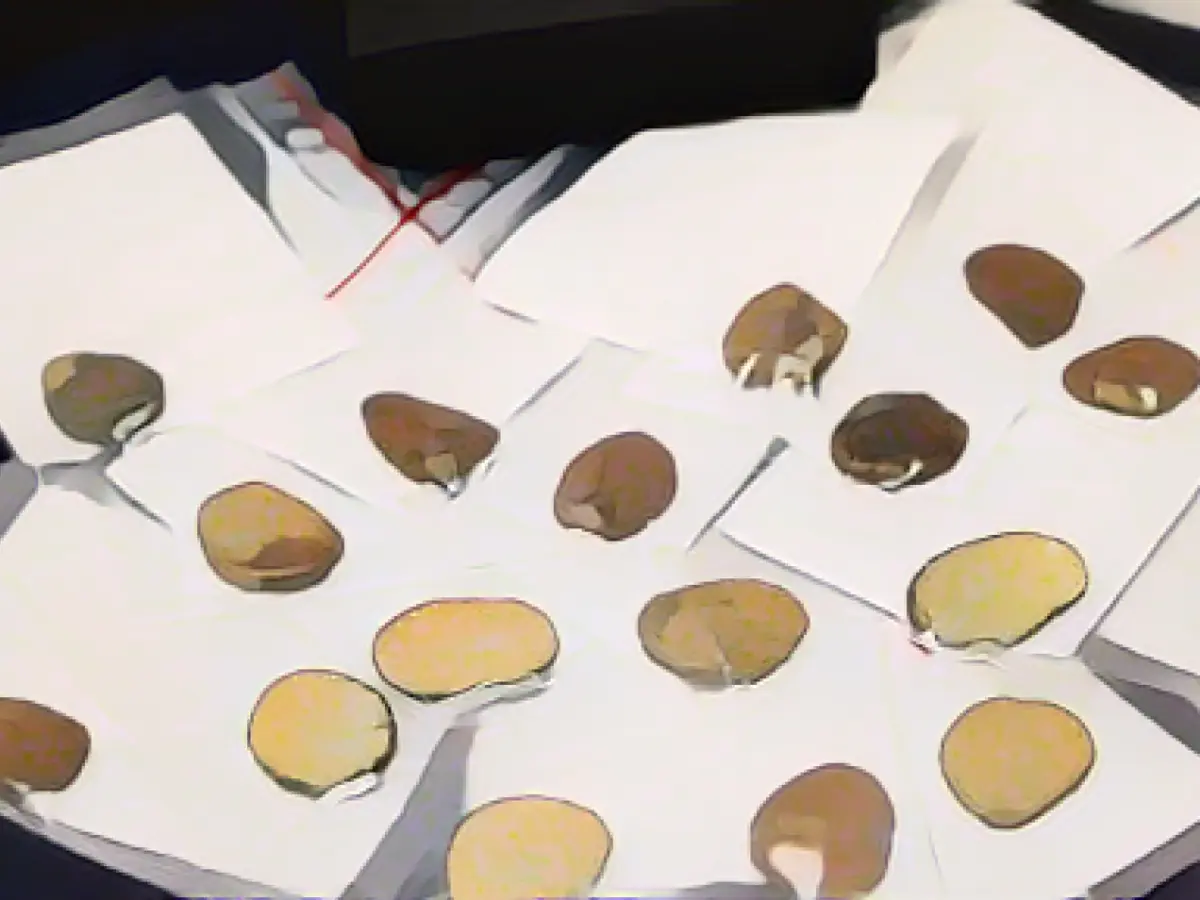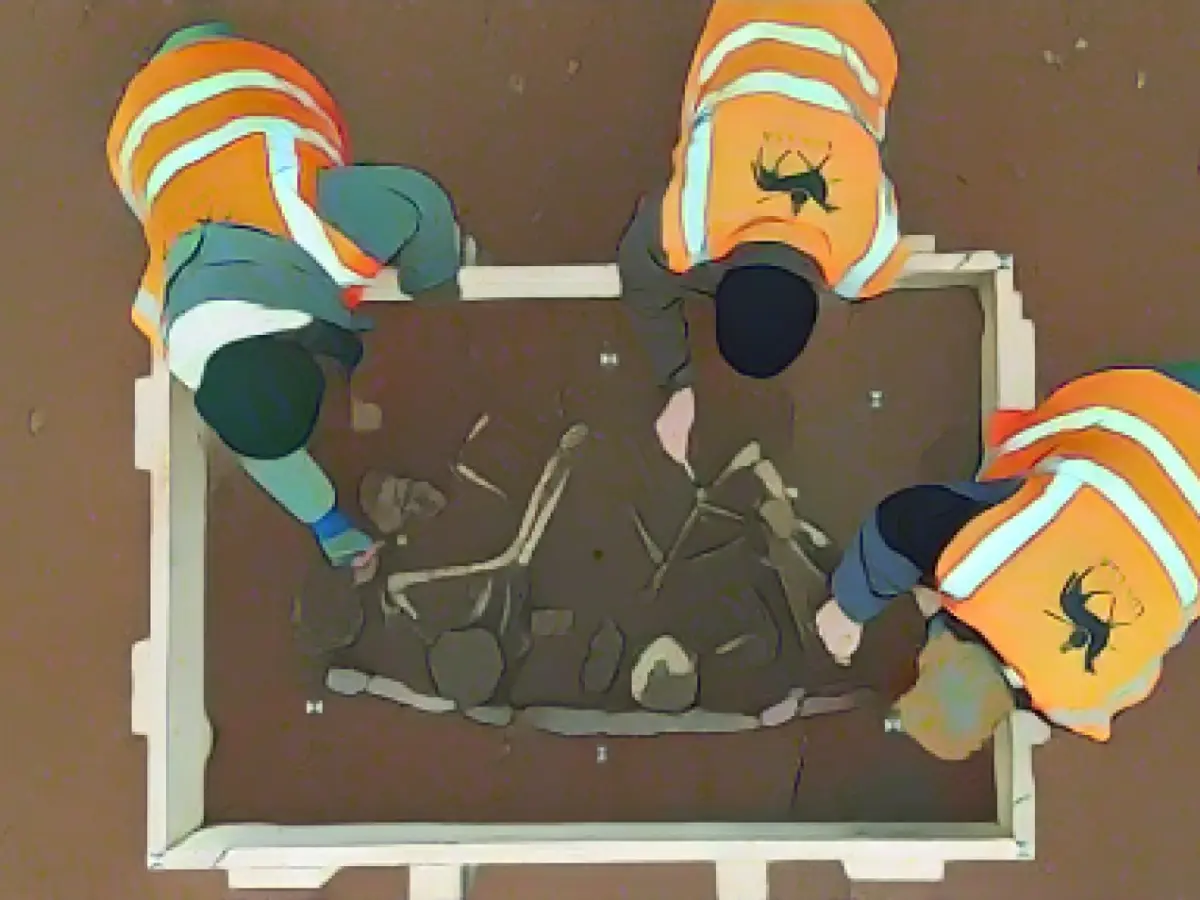Uncovering Ancient Secrets Beneath Intel's Future Site
In the heart of Magdeburg, Germany, archaeologists have unearthed fascinating remnants from two Stone Age cultures right on the future site of tech giant Intel. According to Susanne Friederich, an archaeologist and project manager from the State Office for Monument Preservation and Archaeology, "Two 6,000-year-old burials from the Baalberg culture have been uncovered on a hill, today's Eulenberg" . Such burials on hills are characteristic of the Baalberg culture, whereas their settlements are typically found on slopes.
The discovery of the Baalberg culture graves includes a trapezoidal area, about 30 meters long and 10 meters wide, which may have served as a mortuary hut . The remains of mortuary buildings, now barely discernible in the ground, suggest a mound of earth had been placed on top . Two deceased individuals were discovered; one was a mature adult around 30 years old, while the other passed away at a young age between 12 and 18. Unfortunately, the sex couldn't be determined .
Cattle breeding played a crucial role for the Baalberg culture, known for being Europe's first sedentary settlers .
Deeper excavations on the site also uncovered three Corded Ware burial mounds, dating back roughly 4,500 years . Archaeologist Xandra Dalidowski explained that the foundation trench, used to prevent the rain from washing away material and wooden palisades, suggested the presence of a precious burial inside .
The archaeologists anticipate discovering more traces of the Stone Age settlement on the site, with the primary Intel construction, including connections, set to be complete by 2023 . Interestingly, the upstream areas still require archaeological investigations, set to be finalized by February 2024 . The Intel site isn't at risk, according to the archaeologists.
A fascinating find outside Magdeburg could potentially provide significant insights into Stone Age cultures. Three Bell Beaker Culture burials have been identified near the town of Förderstedt in the Salzlandkreis district, Saxony-Anhalt , dating back to the Eneolithic or Copper Age (2500 to 2050 BCE) . The graves placed individuals in unique positions, with men resting on their left sides facing north, while women lay on their right sides, heads pointing south, both facing east . Grave goods found within the sites hinted at warriors, with bell-shaped ceramic vessels, stone wrist guards, and flint arrowheads present .
This discovery contributes to a broader understanding of ancient trade and migration networks, as the presence of Gotland sandstone reveals long-distance contacts in Northern and Central Europe .
In March 2022, Intel made the announcement that they were planning to manufacture the latest generation of chips in Saxony-Anhalt starting in 2027 . The construction of two semiconductor plants will dominate the first stage of Intel's expansion in the region.
Footnotes
: DPA. (2022, May 18). Two 6,000-year-old graves found on future Intel site. Deutsche Presse-Agentur. Retrieved 2022-12-21, from .
: Secrets of the Bell Beaker Culture. (n.d.). Water, Mills and Music. Retrieved 2022-12-21, from .
The archaeological findings uncovered during the construction of the SuedOstLink powerline in Saxony-Anhalt, not Intel's semiconductor plants, have provided valuable insights. Among these, a 4,500-year-old burial site related to the Bell Beaker Culture near Förderstedt in the Salzlandkreis district, Saxony-Anhalt, has offered key information. The burials, dating back to the Eneolithic or Copper Age (2500 to 2050 BCE), were found at a depth of about two meters and were well-preserved due to being filled with loess clay, which protected them from environmental degradation. Graves showed unique customs, like men being laid to rest on their left sides with their heads facing north, while women were placed on their right sides with their heads pointed south, both facing east. Grave goods, such as bell-shaped ceramic vessels, stone wrist guards, and flint arrowheads, indicated that some individuals were warriors. The discovery offers insights into ancient trade and migration networks, as the presence of Gotland sandstone suggested long-distance contacts between communities in Northern and Central Europe. The Bell Beaker Culture, known for its complex relationships with neighboring societies, invites archaeologists to deepen their understanding of these connections.
The archaeological findings and Stone Age cultures unearthed during the construction of the SuedOstLink powerline in Saxony-Anhalt, not Intel's semiconductor plants, have been extensively documented. Here are the key points:Bell Beaker Culture BurialsArchaeologists have uncovered a 4,500-year-old burial site related to the Bell Beaker Culture near the town of Förderstedt in the Salzlandkreis district, Saxony-Anhalt[2][4].The burials date back to the Eneolithic or Copper Age (2500 to 2050 BCE)[2][4].The graves were found at a depth of about two meters and are well preserved due to being filled with loess clay, which protected them from environmental degradation[2][4].Among the graves, at least ten have been identified, with three originally covered by a burial mound[2][4].The burials show unique customs where men were laid to rest on their left sides with their heads facing north, while women were placed on their right sides with their heads pointed south, both facing east[2][4].Grave goods included bell-shaped ceramic vessels, stone wrist guards, and flint arrowheads, indicating that some individuals were warriors[2][4].Archaeological SignificanceThe discovery offers insights into ancient trade and migration networks. The presence of Gotland sandstone, which was quarried in the Baltic Sea region, indicates long-distance contact between communities in Northern and Central Europe[2].The Bell Beaker Culture is known for its complex relationships with neighboring societies, and such finds invite archaeologists to expand their understanding of these connections[2].
There is no mention of Intel's semiconductor plants in the provided sources. The archaeological findings mentioned are related to the construction of the SuedOstLink powerline.








